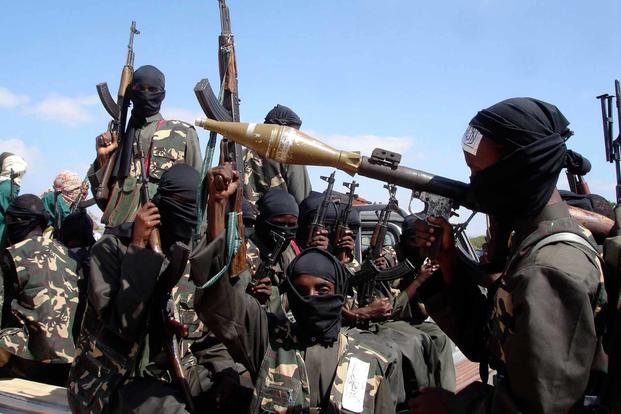Joseph V. Micallef is a best-selling military history and world affairs author, and keynote speaker. Follow him on Twitter @JosephVMicallef.
The expulsion of the Islamic State, or IS, from its "territorial caliphate" in Iraq and Syria did not end its ambition of establishing a worldwide caliphate; it merely shifted its locus elsewhere. Increasingly, the jihadist group is targeting Africa as the most likely area where it can reestablish a second "territorial caliphate."
Islamic State's concept of a caliphate has always extended beyond its territorial domain in Iraq and Syria. That's one reason why it organized "provinces," called wilayats, around the globe.
At last count, IS claimed around 50 wilayats. The Islamic State of Syria and the Levant, or ISIS, the original wilayat, is still considered a province, even if IS no longer controls any specific territory in the region or does so in a transitory fashion at best.
Many of the wilayats exist in name only. Libya, for example, is divided into three wilayats, but IS has a sustained presence in only the southern region of Fezzan (Wilayah al-Fizan). Elsewhere, existing jihadist groups like Boko Haram in Nigeria and al-Shabaab in Somalia briefly identified themselves with Islamic State, pledging support to then-IS head Abu Baker al-Baghdadi, before drifting away and reestablishing their autonomy.
In some areas, wilayats consist of little more than a handful of jihadists and a local leadership council that has pledged allegiance to Islamic State and to its current head, Amir Muhammad Sa'id Abd-al-Rahman al-Mawla.
The situation remains very fluid, with jihadist groups often changing allegiances or splintering into either IS or al-Qaida affiliated groups or maintaining a nominal independence.
Islamic State Post-Syria
The number of IS jihadists who escaped from Syria and Iraq is unknown. Estimates have ranged as high as 20,000. There are an additional 40,000 people, consisting of jihadists and their families, being held by Syrian Democratic Forces, the largely Kurdish-staffed, U.S.-backed militia that fought Islamic State in Syria.
There have also been numerous escapees from those detainees. Over the last year, the Iraqi Kurdish Provincial government in Erbil has proposed to set up courts to try those jihadists, both the ones that fought for IS in Iraq and Syria and those who fought elsewhere. The issue, however, is still under discussion between the Kurdish provincial government and the Iraqi national government in Baghdad.
Following the loss of its territories in Syria and Iraq, Islamic State's leadership sought to set up a new caliphate elsewhere. Libya was once considered a prime prospect amidst the collapse of governmental authority that accompanied the Libyan civil war after the overthrow of the Gadhafi regime.
Indeed, during 2018 and 2019, there were numerous reports that al-Baghdadi had already transferred his base of operations to Libya, accompanied by claims that he had been sighted there. Those reports turned out to be false. Despite initial success, including its takeover of the Libyan city of Sirte, Islamic State's power in Libya was short lived, leading one analyst to describe its trajectory there as "From Force to Farce."
IS tried to inject itself into existing regional conflicts in Afghanistan and Yemen. To a lesser extent, it also became active in the Philippine islands of Jolo and Basilian, supporting the Abu Sayyaf insurgency that has been active there for four decades. Abu Sayyaf is the largest of the half dozen or so jihadist groups active in the Philippines.
In Afghanistan and Yemen IS found a well-entrenched al-Qaida and affiliated jihadist groups, most notably the Taliban. While it was able to draw off some jihadist support, and remains active in both regions, it failed to become the preeminent jihadist group in either area. In the Philippines, despite some initial success, it was quickly crushed by Philippine military forces, although there, too, it retains an ongoing presence.
Islamic State in Africa
It is in sub-Saharan Africa that Islamic State has shown the most traction, and that region is emerging as the locus of its activities around the world.
Initially, besides Libya, the IS presence in Africa was based on its affiliation with al-Shabaab in Somalia, Boko Haram in Nigeria and Ansar Bait al-Maqdis in the Sinai. The latter group had started as an al-Qaida affiliate but pledged its allegiance to al-Baghdadi in November 2014.
Since then, both al-Shabaab and Boko Haram have reasserted their independence from Islamic State and now operate relatively independently.
Their initial pledges of allegiance were made when Islamic State was at the peak of its power and influence, and were motivated in part by the desire to avoid a split in those organizations between pro-IS factions and those factions wishing to remain independent.
IS has now organized splinter groups from both these jihadist organizations into new IS affiliates/wilayats, although those splinter groups are substantially smaller than when IS was at the peak of its influence.
In sub-Saharan Africa, Islamic State now operates through two principal groups. The Islamic State West Africa Province, or ISWAP, covers present-day Nigeria, Niger, Chad, Cameron, Burkina Faso and Mali. The Islamic State Central Africa Province, or ISCAP, covers the Democratic Republic of Congo and Mozambique.
There is also an Islamic State Somalia that operates primarily in the Horn of Africa. It is made up of defectors from al-Shabaab and is relatively small. IS has also organized the Islamic State Great Sahara, or ISGS, wilayat that overlaps with ISWAP, but operates separately.
Jamaat Nusrat al-Islam wal-Muslimin, an al-Qaida affiliated group, operates in the same Central African area as Islamic State. Jihadist militants often move between IS and al-Qaida affiliated groups.
IS also tried to take control of al-Qaida in the Islamic Maghreb, an Algerian-centric organization affiliated with al-Qaida. Despite drawing off some jihadist support, it failed to establish a functioning jihadist group in the Islamic State Algeria Province.
The Islamic State Sinai group has been the most active of the African-centered IS jihadist groups. Beyond some sporadic attacks in Egypt's Nile Valley and the Red Sea coast, however, it has not operated successfully outside of Sinai on a sustained basis. Its most spectacular attack was when it downed a Russian commercial airliner, Metrojet flight 9268, on Oct. 31, 2015.
Wedged in between Israel and Egypt, it is highly unlikely that either government would permit an ISIS-like state to take root in the Sinai Peninsula.
In west and central Africa, however, Islamic State jihadist groups face generally weak governments with typically poorly trained and underequipped militaries -- the exception being the Nigerian military. Nigeria's armed forces have performed effectively against Boko Haram and other jihadist groups operating in the region.
ISWAP's main center of activity is in the tri-country area where Chad, Nigeria and Niger meet. Over the last two years, ISWAP jihadists have overrun more than a dozen military bases in that region. Some of those bases were little more than lightly defended outposts, but others were more substantial and supplied a treasure trove of weaponry and munitions.
ISGS, on the other hand, has largely operated in eastern Mali and the border area with Niger.
If a new "territorial caliphate" were to emerge, most likely it would be established in central Africa, somewhere in the region from Mali to Chad.
France has been actively engaged in countering jihadist activity in West Africa. Most of this region was once part of a French colonial African empire. French companies are actively involved in the resource sector in the region. The U.S. has also been actively engaged with various training missions in the area. It has deployed several Special Forces units in the region and provided logistical support to French forces operating there.
Both the U.S. and French governments, however, have signaled that they are reevaluating their ongoing role in countering jihadist groups in west and central Africa.
In Washington's case, this is part of a broader reorientation from fighting jihadist groups around the world to focusing on competition with near-peer rivals Russia and China.
In Paris' case, it simply reflects the frustration that the almost two decade-long effort has done little to stabilize the region.
While ISWAP has seen the bulk of sub-Saharan jihadist activity, it is in ISCAP that the most significant economic damage has occurred.
In 2012, a consortium led by Italy's ENI and Anadarko Petroleum (now a unit of Occidental Petroleum) discovered the equivalent of seven trillion cubic meters of natural gas just off the coast of Cabo Delgado, Mozambique's northernmost province.
The various gas projects, estimated to be worth some $60 billion, are a game-changer for Mozambique, the world's seventh poorest country. They could transform it into one of the top 10 liquefied natural gas, or LNG, producers in the world. More significantly, preliminary geologic data suggests that it could be part of a larger trend of gas deposits in East Africa's offshore sedimentary basins.
The town of Palma has become the main staging ground for the oil companies exploring the region and will host the LNG processing facilities.
Ansar al-Sunna, a local jihadist group that also goes by the name al-Shabaab (no relation to the Somali group with the same name), pledged its allegiance to Islamic State in April 2018 and now operates as ISIS-Mozambique.
Over the last 18 months, the group has staged dozens of attacks in northern Mozambique, including attacks on Palma and the port of Mocímboa da Paraia that involved hundreds of jihadist fighters. Depending on the estimate used, between 350,000 and 700,000 people in the province of Cabo Delgado have been displaced by the violence.
The Mozambique government and military have been unable to contain ISIS-Mozambique, leading several international oil companies to suspend their activity there. The Mozambique government has had discussions with the South African government on obtaining its military support to contain the violence, but has not yet reached an agreement.
The Islamic State is alive and well in sub-Saharan Africa, and is continuing to expand both its influence and the scope of its activity there.
If a new Islamic State "territorial caliphate" emerges, it is likely to do so in Africa. With Washington now focused on geopolitical, economic and military competition with China and Russia, and with little American or European appetite for continuing the "whack a mole" global fight against jihadists, the likelihood of a new ISIS-like state in sub-Saharan Africa is a very real possibility.
-- The opinions expressed in this op-ed are those of the author and do not necessarily reflect the views of Military.com. If you would like to submit your own commentary, please send your article to opinions@military.com for consideration.















